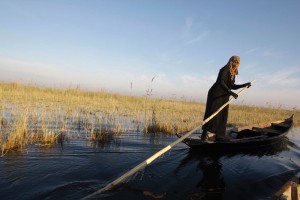The “Garden of Eden” is drying up this summer. Water levels in the fabled Mesopotamian marshes of southern Iraq have reached their lowest levels since Saddam Hussein substantially drained them in the 1990s to starve their inhabitants.
The reason is that the Euphrates, one of two rivers that flow through the marshes, has been reduced to a trickle.
The falling water levels have triggered a crisis. “It’s tragic,” says Hassan Janabi, Iraq’s chief water diplomat. “It happened unexpectedly, and because our focus was on combating terrorism, it went unnoticed.”
Last week, water levels in the marsh town of Al Chabaish were half the normal levels for the time of year, according to Jassim Al-Asadi of Nature Iraq, a conservation NGO. “The amount of water from the Euphrates reaching the marshes is less than a tenth of what is needed,” he says. This is happening despite near-normal rainfall.
Suzanne Alwash of Mt San Antonio College in Walnut, California, a wetlands ecologist who knows the marshes well, says: “Salinity has doubled, water buffalo can no longer drink from the marshes, and fish [deaths] are common.”
Blame game
In June, the Iraqi parliament’s agriculture and water committee blamed the crisis on Turkey, where hydroelectric dams block the river’s upper reaches. It accused Turkey of breaching a deal to deliver 500 cubic metres of water per second out of the country down the Euphrates. The head of Turkey’s directorate of state hydraulic works did not respond to questions on this, though New Scientist has been told that flow has resumed in recent days.
Iraq’s parliamentarians also blame ISIS, which in May captured the river’s Ramadi dam. The group has reportedly cut supplies to government-controlled areas further downstream – including the marshes – by using the dam to divert water into nearby Lake Habbaniyah, which is intended to take wet-season floodwaters. In addition, it may be on the verge of taking over the Haditha dam upstream, which would give ISIS total control of the Euphrates in Iraq.
But a third culprit may be the Iraqi government, which is anxious to exploit the river’s waters in a hearts-and-minds battle to hold back ISIS.
Azzam Alwash, head of Nature Iraq, says that three-quarters of the water reaching the edge of the marshes at the city of Najaf has recently been diverted to irrigate the fields of the area’s rice farmers, who back the government. To protect the marshes, “the government’s own stated policy is not to allow rice growth in years of little water”, he says.
Saddam constructed huge engineering works in the 1990s to divert the Euphrates and Tigris rivers away from the marshes – which once covered 10,000 square kilometres of southern Iraq – to force out rebels who lived there. After his downfall, Azzam Alwash returned from exile in the US and spent more than a decade masterminding a plan to reflood the marshes, as well as persuading the Iraqi government to create a national park there.
But recent events have put his plan into reverse. More than half the area is now desiccated once again.


